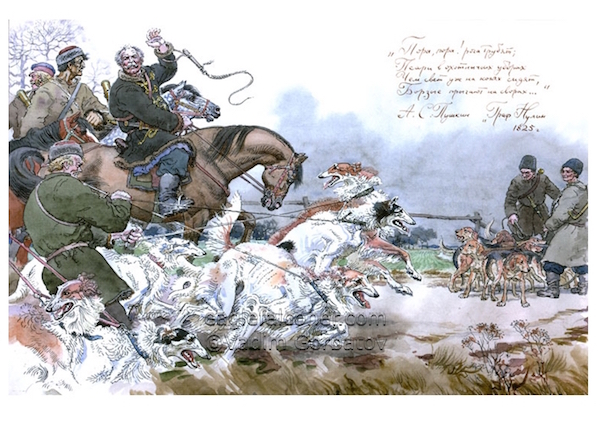
We can scarcely imagine how it must have been to be lord of a Russian manor some 150 years ago. Hardy a wealthy estate was found that didn’t breed at least a few Borzoi since hounds and hunting had been the custom throughout Russia for generations.
Every Russian nobleman of any consequence has his “hunt,” which was accorded a good deal of seriousness. Kennels and kennel help were outfitted in one color, horses and their horsemen a different color, and the hunt livery all of one hue.
Among the grandest was Grand Duke Nikolai Nikolaivitch’s kennel.
In 1887, Nikolaivitch purchased the Perchino estate 20 miles from Tula where he concentrated on a breeding program (some sources write that most present day Borzoi descend from the Perchino type). His first Borzoi was a black and white dog known as “Udar,” Soon after, the Duke obtained “Osornoi,” who was marked with red. Together, these two great dogs made up his first team. In time, “Chitschny,” “Atlan,” “Sawladei,” and “Nagradka” were added. In all, the Grand Duke kept 365 dogs of all colors, including solid black, a color huntsman of the day found necessary to keep. Of the Duke’s dogs, 100 hounds were kept for hunting on horseback, along with 130 Borzois, 15 Greyhounds trained for hunting, as well as the old dogs and puppies. Some 78 staff members acted as veterinarians, coachmen, administrators, beaters, hunters with the Borzois, and kennel help. As enormous as the facility was, an even bigger kennel was kept by the landlord, Samsonoff, at Smolensk with approximately 1,000 dogs where prized Borzoi often had personal servants to cater for their needs, the dogs usually housed and fed better than most of the population.
When serfdom was finally abolished in 1861, many nobles could not afford to continue in their previous lifestyle. The huge estates were broken up, the kennels disbanded and the Borzoi fell on hard times, with only a few of the richer nobles and enthusiasts keeping the breed going.
Image of a scene dated 1825 and believed to be of hounds men working for the Royal Kennels of the Grand Duke. Found on Pinterest and happily credited upon receipt of information

This is a daughter of an imported Russian Borzoi and an American bred mother. A delightful dog in every way! Oxota Molodezovna Hatsya or Hotsi as we call her!
Leigh, she’s stunning!